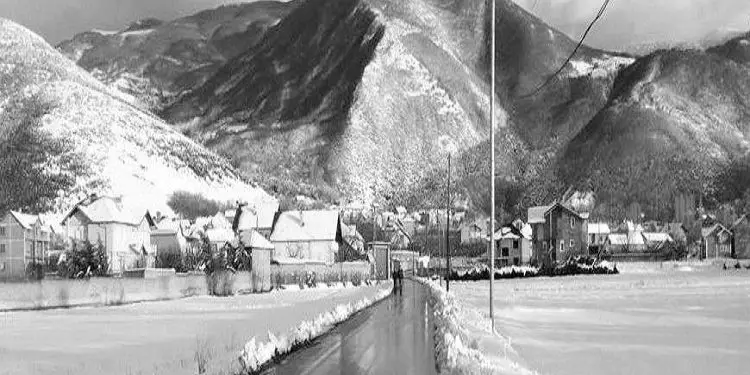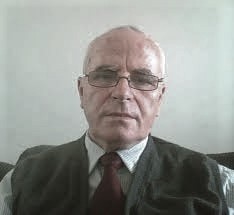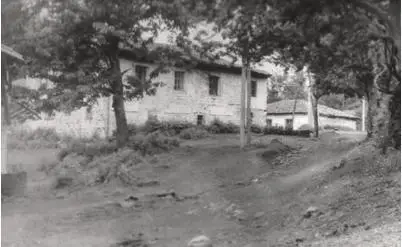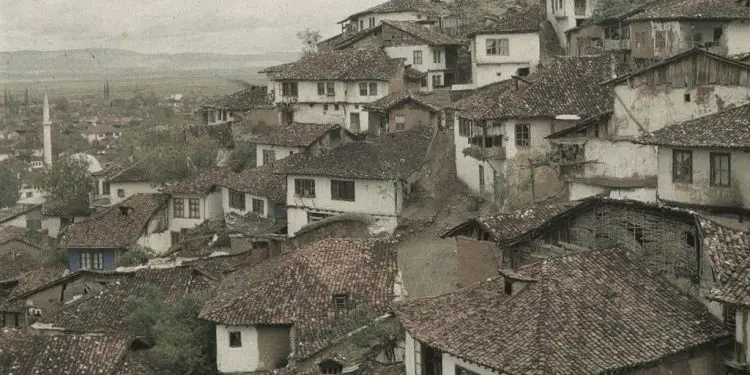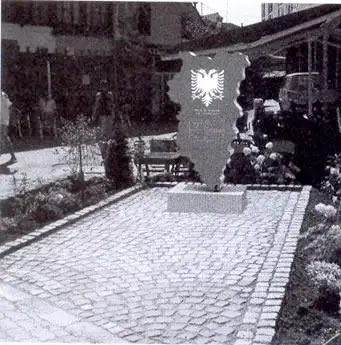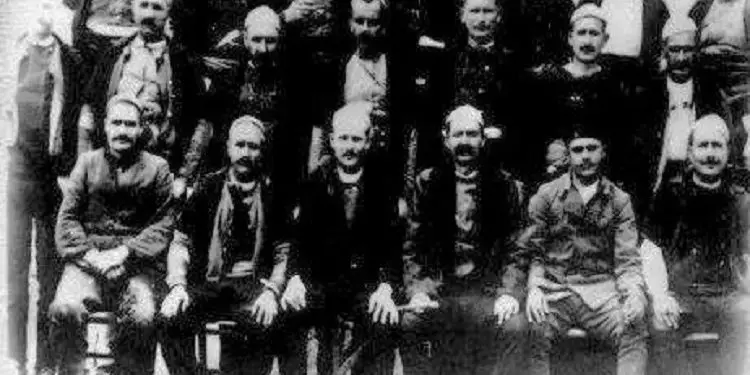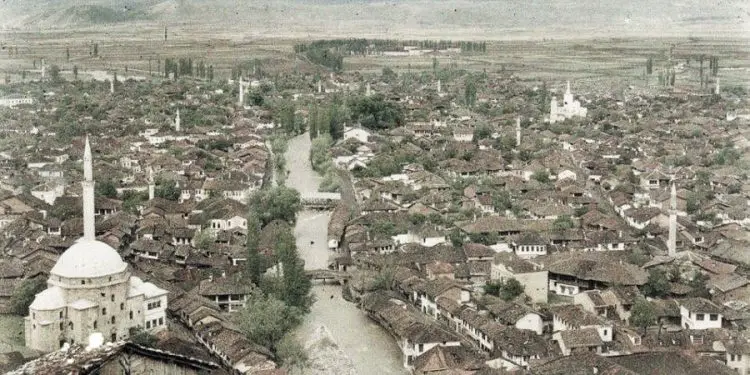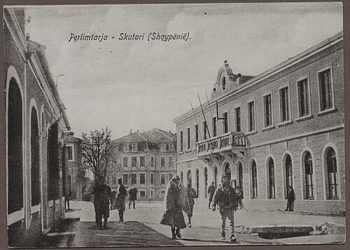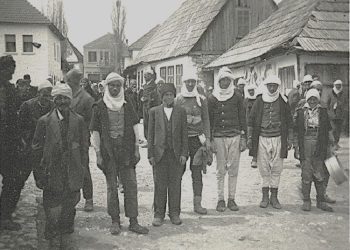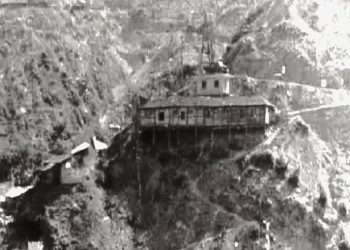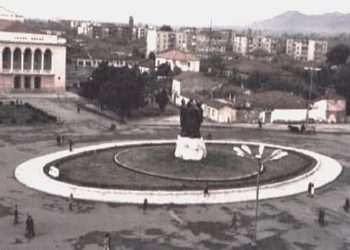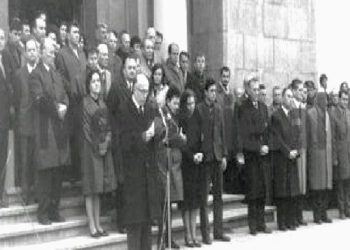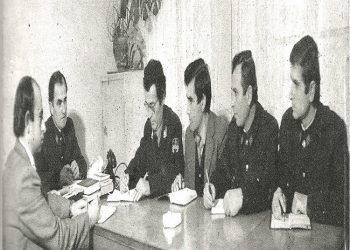By SABIT ABDYLI
Memorie.al / The village of Kabash is located at the foot of the mountains of Kopilaça, now completely united with the town of Viti, on the southern side with a hilly-mountainous area, while on the northern side, with flat agricultural areas. On the eastern side, it is bordered by the Morava River, and on the western side, by the village of Smirë. Kabashi is one of the youngest villages in Upper Morava. Kabash was founded by the Kabash people who came from Kabash of Prizren, in the second half of the 18th century, between 1780-1785. Today, Kabashi is one of the largest villages in the Municipality of Vitia, with nearly 400 houses and 3,000 or more inhabitants.
With the disintegration of the Ottoman Empire in 1912, Serbian troops occupied Kosovo. Upon reaching Kosovo: “The Serbian officers (writes the New York Times, December 31, 1912), ordered the most efficient way to pacify the Albanians, i.e. their total disappearance. In many villages, houses were burned. When the unfortunate residents tried to escape the flames, they were killed like rats. Men were killed in front of women and children. Then, they forced the women to watch their children while they brutally stabbed them with bayonets”.)
Even the Kabashes did not escape the Serbian plans for the systematic extermination of the Albanians. In the second part of October 1913, a group of kachaks led by Rrustem Januz Kabashi, (1891-1914), descended from the mountain to the village, were investigated by Serbian guards and their calls to surrender, to show who they are, the Kachaks retaliated with weapons, killing two Serbs. The event takes place late in the evening, on the western side of the village mosque, 20 meters away.
One of the Kabashians alerts the village about the danger after the murders of the Serbs, shouting in the streets of the village: “Get out of the village; it’s been an hour since we’ve lost our skins”! (Leave the houses, get out of them an hour before (as soon as possible) before the Serbs attacked us.) According to Ruhan Abdyl, 1906-1983. Fearing that they would be found guilty even those Kabashes who heard about the danger, did not leave their homes.
The Serbian conqueror had been waiting for such an occasion for a long time, to vent his chauvinistic desires on the Kabashes to change the ethnic appearance of the village. That night the entire village was surrounded by multiple forces of gendarmerie, army and Serbian civilians. According to the testimonies of those who remained alive, who experienced the massacre, in the morning of that fall, all males over the age of 15 were arrested.
First, the arrested were cornered in the village mosque, under the pretext that they are doing investigations. That same day, the arrested are sent (locked) to the King’s Tower in Viti. The tower was at the crossroads where the road from Debelldas village to today’s fruit and vegetable market splits. Before 1912, this tower was used by the Turkish gendarmerie, and later by the Serbian gendarmerie, as a command post.
What the Serbian army failed to do in 1912, as it did in the neighboring villages, when children were burned, massacred, and even shot: in Smira, in Goshicë, in Lugishte (Lubishtë), in Mogilla, in Mollëkuq (Trestenik), etc. ., this opportunity had to be used to wipe out from the face of the earth the inhabitants of the village of Murneč, who in 1912 had escaped with only one killed (Vesel Hasanin, 43 years old) and to “realize Serbia’s plan for colonization , better to say about the serbization of countries where the population was mostly Albanian” (Dr. Millovan Obradović, Agrarian reform and colonization in Kosovo, 1918-1941, Pristina, page 5.)
The village had not yet managed to heal the wounds caused by Shefqet Turgut Pasha (1910), when almost half of the village was burned and the brothers Adem and Mustafa Kabashi, inspirers, organizers and participants of the war in Gryka e Kaçanik and in the Morava Valley against Turgut Pasha, and here came the other, even wilder and crueler occupier. “At that time, Kabashi had 424 inhabitants…” (Mr. Rexhepi “Kabashi of Upper Anamorava”, Pristina, 2003, page 12). In the King’s Tower, the arrested were held for two days.
On the third day, in the evening, on foot, tied with friends of the arrested, hand in hand, two by two and with large security forces, they start for Gjilan. This is how they lied to the prisoners, as if in Gjilan, they would bring them before the court of “justice”. And on the other side, they had prepared the abyss where they would massacre them. They set fire to the village. All the houses, the plevicas, the fences were burned, except for two houses, which stood the fire, or were left on purpose (the house of Rexhep Çauşi and that of Hetem Hasan). In Plevica, where they were hiding, 40-year-old Zenel Rexhepi, 20-year-old Qazim Shabani, Rrustem and Shaban Sallahu, one 19 and the other 17, were burned in the presence of their mother, who fought with the gendarmes for to save the boys, 48-year-old Ibish Jakupi was killed in the village,
Agush Ahmeti, 30 years old, was also killed at the exit of the village. Murat Salih Abdylin, 50 years old, sick, dressed in a shirt and trousers, is killed by his former servant, after he was released as sick. The murdered man was buried at the scene, 300-350 meters away from Kulla, at the end of the road at the entrance to the village of Kabash, 30 m., near the Miftijaj mill, next to the elbow where the petrol pump (Fuel) is now built. The village was looted. All valuable things were stolen: dowries of brides and daughters, dairy, beans, stored winter crops, corn, wheat…! The doors of the courtyards, barns, carts were observed until recently in the houses of looters in Viti, Binçë, Vërbovce and Kllokot.
Jahi Selmani (1896-1968), a person who escaped being shot, after many years, in the barbershop of Misin Kabashi, in Gjilan, Gata Veleshani from Velekinca, the executioner in the great prison of the Kabashi, saw in his hand the box of silver for the tobacco and amber of Aziz Abdyl (village lord, shot). What misery, the slain have been plundered! The looters took everything with them, leaving behind only the oil of mothers for the sons, the oil of the brides for the men, the oil of the children for the parents and the curse of the women to the murderers, the barbarians.
The village smelled of gunpowder for weeks. The rumor of the killed was heard for days. 54 people were killed, stabbed and buried there, (perhaps even more) some alive, in a previously prepared pit at Zabeli i Sahit Aga, near Kllokot (now the property of Banja e Kllokot) .
According to Jahi Selman, who witnessed the event, where his compatriots were massacred, he said that after the call of Rexhep Çauşi (1850-1913), who although he was sick (“…the Serbs had taken him from his bed… ” (Mr. Rexhepi “Kabashi i Anamorava e Epërme”, Prishtina, 2003, page 57), found strength, with that rifle voice of his, full of nerve and explosive, as once in the war of 1910 against the Turkish army in Kaçanik and the villages of Upper Morava, to give courage to the Kabashians: “Stand up brother, don’t give up… you have to fight against the enemy even with tied hands”!
After his call for resistance, a lightning revolt broke out, a tumult and confusion mingled with rifle fire and deafening shouts. Terrified by the revolt of the arrested, the guards lost control and began to attack the prisoners without stopping. During the riot, it is said that gendarmes were also killed.
Thanks to this unprecedented opposition, in addition to Jahi Selman, Feriz Osmani, Ramë Kaçarremi, Deli Muçaj and Qerim Mehmetuka managed to escape alive. Among those killed, there were also guests who were found that fateful night in Sylë Jashari’s room. There were three of them, one of them son-in-law of uncle Syla from Ballanca, a village in the municipality of Vitia. In this plot, another guest from Mogilla, Misin Luzha, was killed.
The village remained in the hands of women and children. Most of the mothers raised their children in the village, to return after three years, and to restart life in the burnt village. With great effort, they managed to heal their wounds a little and become lords of the lands that they left their first trusts. They did not forget the words, the message of Bajram Curri, Isa Boletini, Mustafa Kabash, in 1909 before the liberation of Skopje, where they stayed two nights in Kabash, to mobilize the people in the war against the Turks. Since then, they had told those gathered in the courtyard of the village mosque: “This land is ours. Let’s preserve and protect it like the eyes of the forehead”! (According to Sakip Misin Salihu, 1882-1961).
The vicissitudes are not uncommon. Houses and everything else they needed for life had to be built. Some families were extinguished, others moved to Turkey. Then the colonization of the village with Serbs from Vllasina began. The land is taken from them, but the desire to live in the lands of the ancestors persists.
After a research, I found the names of 44 killed Kabashes and three guests, while the others are from extinguished, displaced families, or the number of those killed was probably less than what was said.
It is a pity that the place where the massacred are buried has been covered with thorns and is not marked with anything. This irresponsibility to the past, to those killed, is not forgiven, this irresponsibility is ordered by the killers, it is harmful, against us, against our national interests, against the future. None of the mass cemeteries (over 350 victims) of 1912-1913 in the municipality of Viti are marked.
Big shame! Responsible, decent people should step in an hour or so earlier. Mark these places of slaughter, because the blood spilled even without the will of the massacred punishes us. To write the history of those who were shot, to show ourselves, the generations, the world, that the massacres, the massacres of the Albanians, date back to the period of the establishment of the Serbian state.
Names of those executed:
- Misin Salih Cenaj, (52-year ),
- Murat Salih Cenaj (50),
- Avdyl Salih Cenaj (32),
- Hysen Jakup Cenaj (35),
- Ibish Jakup Cenaj (52),
- Isak Jakup Cenaj (31),
- Agush Ahmet Cenaj (30),
- Hamëz Nezir Cenaj (18),
- Qerim Ali Cenaj (50),
- Alush Ali Cenaj (26),
- Hafiz Qerim Cenaj (22),
- Halit Qerim Cenaj (20),
- Azem Kamer Cenaj (48),
- Sefedin Azem Cenaj (16),
- Aziz Elez Cenaj (47),
- Rexhep Çaush Veselaj (63),
- Smajl Bajram Veselaj (60),
- Bajram Smajl Veselaj (39),
- Hamit Selman Veselaj (50),
- Jashar Islam Muçaj (60),
- Islam Jashar Muçaj (30),
- Murtez Brahim Muçaj (52),
- Hamdi Murtez Muçaj (17),
- Kadri Brahim Muçaj (37),
- Isuf Brahim Muçaj (22),
- Qamil Osman Muçaj (18),
- Zenel Rexhep Muçaj (40),
- Hazir Shaban Muçaj (45),
- Qazim Hazir Muçaj (20),
- Shabi Sadik Muçaj (37),
- Ramadan Ramadan Kuklubeci (30),
- Rrahim Sallah Trakalaçi (53),
- Ali Sallah Trakalaqi (50),
- Hebib Ali Trakalaçi (25),
- Aziz Avdyl Trakalaçi (47),
- Faik Aziz Trakalaçi (19),
- Abaz Sallah Trakalaçi (65),
- Veli Abaz Trakalaçi (45),
- Rrustem Veli Trakalaçi (19),
- Shaban Veli Trakalaçi (17),
- Hysen Abaz Trakalaçi (18),
- Misin Luzha (mysafir, fshati Mogillë),
- Shefki Qerimi (mysafir, fshati Ballancë),
- Tahir Musliu (mysafir, fshati Ballancë).
(Fragment taken from the book: “Na Kabashi jem t’ndam nji vulmi”, Gjilan, 2013, Sabit Abdyli). Memorie.al




